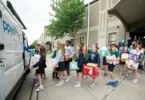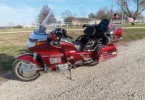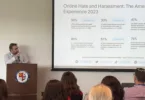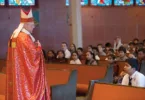by Jessica Langdon
jessica.langdon@theleaven.org
ROELAND PARK – Don’t let the cute names fool you.
Bishop Miege High School’s robotics team named a few key pieces of its latest creation after characters from the movie “Monsters, Inc.” — but this is no child’s play.
“We’re very professional,” said senior Tim Moore, the team’s shop foreman. “This is kind of how a small business operates.”
After all, the FIRST Robotics Competition is serious business, and close to 50 Miege students have made a monster time commitment to this team.
Entire shifts of students, coaches and mentors have devoted hours of brainpower, physical labor and trial-and-error experimentation to the building of a great robot. They have met every day after school and on Saturdays since early January.
That’s when the renowned FIRST competition announced this year’s robot requirements.
FIRST — an acronym for “For Inspiration and Recognition of Science and Technology” — is the international youth organization that sponsors the annual robotics competition. Referred to as “the varsity sport for the mind,” simply participating in FIRST — i.e., creating a robot that can perform the tasks required to compete that year — pushes students to hone their math and science skills well beyond the classroom.
With limited resources, and this year — because of the snow — even more limited time, local teams are gearing up to test their robots’ mettle March 13-15 in the Greater Kansas City Regional at the Metropolitan Community College – Business and Technology Campus in Kansas City, Mo.
The announcement in January launched six weeks of intense effort to build a bot that can hold its own in a game that pits an alliance of three robots against another threesome.
Early in the design phase, the Miege students dubbed this year’s robot “Boo” because a piece of plywood they used resembled the little girl’s door in the movie.
The robot must hurl a ball (nicknamed “Mike Wazowski” after the round monster character) into a high goal and lob it into a low goal.
And the driver’s station from which students will remotely guide the robot’s movements in competition became “Sulley,” after the burly blue monster.
The 2014 competition adds a plot twist that distinguishes this game from previous ones.
In the aptly named “Aerial Assist” game, teams will reap big rewards by cooperating and passing the ball among all robots within their alliances.
“If you don’t cooperate with each other, you’re not going to go anywhere,” said Miege science teacher Scott Anderson. Anderson, along with fellow teacher Andrew Groene, coaches the robotics team.
Although the team had to weigh the best ways to make their robot grab and shoot the ball — and work well with others — it’s safe to say the students themselves have the latter down to a science.
A program is born
When Dr. Joe Passantino, president of Miege, sees students working side by side on a robot today, he can’t help but picture many of those same kids someday completing projects at engineering firms.
“Our robotics program is a great opportunity for our students to have a hands-on experience that promotes the building of science, engineering and technology skills,” he said. “The whole process, from design to the actual competition, requires a great deal of teamwork and problem-solving — both lifelong skills.”
It’s impossible to replicate this experience in any one classroom, he believes. The birth of Miege’s robotics team dates back to 2007.
Even Anderson didn’t grasp the magnitude of what he was agreeing to when Dan Ritter, a longtime friend and fellow track coach, approached him with the idea.
“We didn’t know how to build a robot,” said Anderson. “It was a lot bigger deal than we’d planned on.”
The 15 seniors and four freshmen of that first team logged many a late night to construct a working robot out of the pieces FIRST sent them and other odds and ends they dug up.
The product of all their labors couldn’t necessarily do much, but it was sturdy and it ran well, and a skilled driver operated the controls.
With that — and another team deciding they’d rather have Miege as an ally in the tournament than go against Stag Robotics — Miege claimed an exhilarating rookie regional win in Kansas City, Mo.
That qualified the team for nationals.
“We went to Atlanta that year,” said Anderson, “and the students got all fired up — ‘Oh, this is a great program!’
“And the rest is history.”
Wide variety
Today, Stag Robotics boasts about 45 active members — male and female — spanning all grade levels.
And it looks nothing like Moore envisioned back when he first heard of such a team as an eighth-grader.
“Honestly, the image in my head was a couple kids going over to someone’s house, and they were out in the garage kind of tinkering around on stuff,” he said.
Instead, computer-aided design helps the team map out plans, and members keep detailed logs of the parts that go into a creation.
Senior programmers pair up with sophomores to train future leaders.
Students shadow other talented students to build skills.
And alumni keep an active hand in current students’ endeavors, sharing their educational and professional expertise. Alumni Tim Mourlam, Billy Hendricks and Victoria Amor — all 2007 Miege graduates — are working with this year’s team.
And if you’re looking for a typical “robotics kid,” Anderson assures that doesn’t exist.
“It’s one of the widest varieties of kids you’re going to see,” he said.
Athletes, artists, musicians, kids who do debate and forensics — it runs the gamut.
“We have so many people who are doing crazy amounts of other things,” said Brianna Wallace, a junior and the team’s science officer. “Some people are really involved with choir and musicals. They do all that but they make time to be here, too.”
The girls hold their own with the guys, said Wallace, but she’d love to see even more join their ranks.
“We try really hard to get everybody involved and everybody learning and being a part of what we’re doing,” she said.
A perfect example? The night Nolan Gray, a member of the robotics team and backup quarterback, had his first varsity football start — and a win.
“As part of our fundraising efforts [for the robotics program], we clean up the stadium after every football game,” said Anderson. “So [that night], we’re up in the stands cleaning up, and I turn around — and here’s Nolan in his street clothes cleaning up the stadium.
“That’s just the kind of kid he is. We’ve got great kids.”
Daniel Becker, a senior who transferred to Miege as a sophomore, certainly found that to be true.
As soon as he wrapped up his last final at his previous school, he visited Miege’s shop, met leaders of the robotics team, and pitched in on cleanup.
“So before I ever stepped into Miege’s halls as a student, I was part of the Miege robotics team,” said Becker, who is on the build team and is first officer, right hand to captain and senior Xavier Hernandez.
Becker has met his best friends on this team — and, believe it or not, he had never picked up a tool before robotics.
“It’s just been a huge, huge step in my life because it’s also solidified the idea that I want to be an engineer,” he said.
‘Kaleidoscope’ of robots
Moore likes the idea that this problem-solving team creates a fun experience now but, down the road, the FIRST name will grab attention on resumes and applications. “It’s a global thing, so people all around the globe do the exact same game we’re doing,” he said. “And it’s amazing, because when you go to competition, it’s a kaleidoscope of different robots. There’s no one way to do things, so it’s a great, kind of cool, eye-opening experience.”
All the kids know better than to get too attached to their robots, however.
“Our robots don’t live very long,” confessed Coach Anderson.
Even the first robot that went to nationals met a quick demise.
“The very next year, we had to cannibalize it to make our next robot,” said Anderson.
Nothing compares to watching this competition among schools from across the Midwest unfold, said Passantino.
“The problem-solving that goes on between rounds would be similar to repairs in the pits at a NASCAR race — pressure-packed, as they try to make the needed modifications to the robot before the next round,” he said.
Anderson recalls one such heart-pounding moment.
The robot’s transmission seized up, a problem that required a couple hours to fix — but the robot had to return to the field in 30 minutes.
Another coach later described the scene to Anderson.
“He said there were just like six sets of hands rapidly flying over this thing and everybody else just kind of backed away,” said Anderson.
No one talked.
“We got it all together as best as we could and sent it back out on the floor,” he said. “I walked over to stand with the students who were there and all I told them was, ‘Say a little prayer because I don’t know if we got this put together right.’”
The buzzer sounded and the student driver hit the joysticks.
“It moved, and we all started cheering,” said Anderson.
Prayer and problem-solving
The team doesn’t lean on prayer only during those make-or-break moments.
“We pray before everything we do,” said Anderson.
At the start of a shift, Moore prayed that everyone would use their unique talents to the best of their ability. And when the team first moved into its current location on north campus, a student had a crucifix blessed for it.
The academic and life lessons that team members are learning are endless.
As Moore said, this team operates like a business in many ways. Its own marketing team spreads the word about robotics. The Robostag mascot shares robotics spirit at school events.
A grant from the Kauffman Foundation funded the team for the first year, with lesser amounts coming in for a few years after that. But Miege had to prepare to stand on its own, said Anderson.
So keeping with its motto of “We solve problems,” the team figured out ways to afford the competition registrations and other expenses.
They work concessions for Catholic Youth Organization events.
They installed most of the school’s SMART Boards to help keep dollars inside Miege, instead of paying someone outside to do the work.
“If we can build robots, we can install SMART boards,” explained Anderson.
Several team members serve as disc jockeys at school dances.
But as the robotics students learn to carry out serious responsibilities, they learn something else as well: Don’t be afraid to make mistakes.
In fact, one of Passantino’s most cherished robotics memories stems from the team’s willingness to try something new with an old tradition — and a messy miscalculation.
“There’s been a lot of successes to the robotics program,” he said. “But my favorite moment was not a success.”
Instead of launching the traditional T-shirts or even hot dogs from a device they built themselves, someone a few years ago came up with something new to launch during halftime of a Stags bas- ketball game: Twinkies.
“It just disintegrated into all kinds of pieces all over the floor,” said Passantino with a laugh.
Cleanup on the court prolonged half- time.
“And that was the last Twinkie launch,” said Passantino.
But it was nowhere near the last adventure of this team of intrepid inventors.
“It does so much for our students. It’s really a great program,” said Passantino. “I think there are leadership skills and a self-confidence that come from working together and solving problems.”






